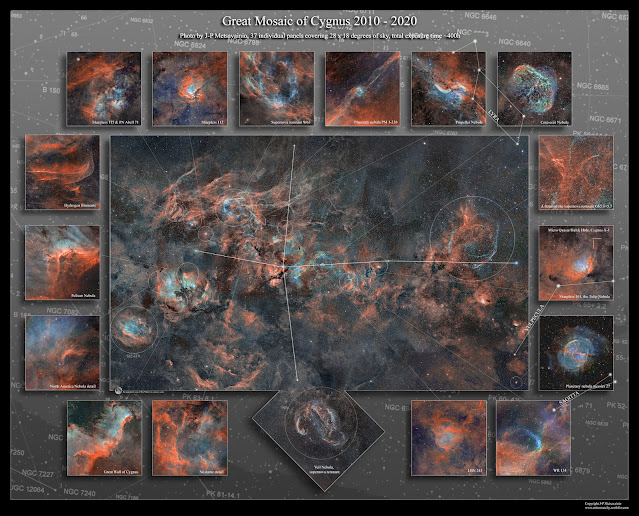COPYRIGHT, PLEASE NOTE
Thursday, February 18, 2021
Sharpless 132, sh2-132, with new data
I have shot a large four panel mosaic out of the Sharpless 132 emission Nebula at february 2019. At the time I was using the Celestron EDGE 11" telescope with reducer. Sh2-132 locates in the border of Cepheus and Lacerta at distance of about 10 000 ly.
I shot same object with a shorter focal length instrument, the Tokina AT-x 300mm f2.8 camera optics. Since the system is kind of undersampled, I got a very deep image of Sh2-132 just with four hours of exposures.
I have now combined those two images and the result has the best out of both worlds . All the high resolution details and the high signal to noise elements are from the long focal length photo and the dim background stuff is from short focal length photo. I have a new processing method to do this and it turned to be a very powerful for a work like this. I call it to VARES-method. Variable Resolution imaging. will be good tool when I want to go very deep very fast and have a high resolution details at the same time.
This is a way to combine best out of the correctly sampled and under sampled optical configurations!
I think this image is a good sample what VARES-technique can do.
Sharpless 132
Click for a large image
A version with out VARES method can be seen here, https://astroanarchy.blogspot.com/2019/02/sharpless-132-sh2-132.html
Celestron EDGE 11" telescope with reducer
5nm H-alpha 3nm S-II and 3nm O-III
Tokina camera optics
O-III, 3 x 1200 s, binned 1x1 = 1 h
S-II, 3 x 1200 s, binned 2x2 = 1 h
Celestron telescope
O-III, 24 x 1200 s, binned 4x4 = 8 h.
S-II, 18 x 1200 s. binned 4x4 = 6 h
Monday, February 15, 2021
Zooming in to a heart of the Heart
Since I have shot many targets with various of focal lengths I'm able to make zoom in series out of my material. This is a nice way to show the fractal nature of our universe, there is always something new to see when the detail level gets higher.
Click for a large image
NOTE, an apparent size of the Moon is marked in third photo for a scale.
photos used for the zoom in series
- https://astroanarchy.blogspot.com/2020/01/deep-in-to-my-heart-ic-1805-in-mapped.html
- https://astroanarchy.blogspot.com/2015/04/my-last-imaging-project-for-this-winter.html
- https://astroanarchy.blogspot.com/2015/04/melotte-15-new-revision.html
Thursday, February 11, 2021
APOD by NASA, Astro Anarchy gets published
Monday, February 8, 2021
Cygnus mosaic in visual colors
I have published this image in mapped colors at December 2020, it can be seen here, https://astroanarchy.blogspot.com/2020/12/cygnus-project-grande-finale-for-now.html
I have started this imaging project back at 2010. My aim was to make a high resolution mosaic covering the constellation Cygnus. Work like that takes time and patience, especially since I have worked so, that many of the individual sub mosaics or frames have been published as an individual artworks. Here is a poster format presentation about all of longer focal length images used for this mosaic beside wide field panels, https://astroanarchy.blogspot.com/2018/11/treasures-of-swan.html
As a result I have now a huge 37 panel (And 58 long focal length sub-panel) mosaic panorama covering 28 x 18 degrees of sky. I have collected photons way over 400 hours during past ten years for this photo. The full size mosaic image has a size of about 25.000 x 15.000 pixels.
A photo of five million stars*
Great Mosaic of Cygnus (2010-2020)
28x18 degrees, 97 panels and over 400 hours of exposure time
The full size photo is worth to see! (2700 x 1700 pixels) An apparent size of the Moon is marked as a scale at bottom left of the picture frame.
An apparent size of the Moon is marked as a scale at bottom left of the picture frame.
This is a large area of sky! (28 x 18 degrees) Image is in visual colours, from the emission of ionized elements in the area.
* I actually counted the stars and in this field of view there are little over five million individual stars!
Three supernova remnants, two Wolf Rayet stars and a black hole
Please, click the image for full resolution
Beside three supernova remnants there are two Wolf Rayet stars with outer shell formations. NGC 6888, the Crescent Nebula at center of the image and the WR 134, it can be seen as a blue arch just right from the Crescent Nebula, near the Tulip nebula.
Next to the Tulip Nebula lays a Black hole Cygnus X-1, it's marked in small closeup image of the Tulip Neula at center right in orientation image above.
Constellation Cygnus is an endless source of celestial wonders, both scientifically and aesthetically. For me, as an visual artist, this are of night sky is very inspiring There are endless amount of amazing shapes and structures, I can spend rest of my life just shooting images from this treasury.
Click for a large image
Here is a poster format presentation and a list all of longer focal length images used for this mosaic beside the actual panels, https://astroanarchy.blogspot.com/2018/11/treasures-of-swan.html
Couple of close ups to show the resolution
Click for a large image




















